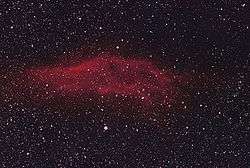California Nebula
The California Nebula (NGC 1499) is an emission nebula located in the constellation Perseus. It is so named because it appears to resemble the outline of the US State of California on long exposure photographs. It is almost 2.5° long on the sky and, because of its very low surface brightness, it is extremely difficult to observe visually. It can be observed with a Hβ filter (isolates the Hβ line at 486 nm) in a rich-field telescope under dark skies.[1] It lies at a distance of about 1,000 light years from Earth. Its fluorescence is due to excitation of the Hβ line in the nebula by the nearby prodigiously energetic O7 star, xi Persei (also known as Menkib, seen at center below it in the inset at right).[2]
The California Nebula was discovered by E. E. Barnard in 1884.
References
External links

 Image of the California Nebula with amateur telescope.
Image of the California Nebula with amateur telescope.